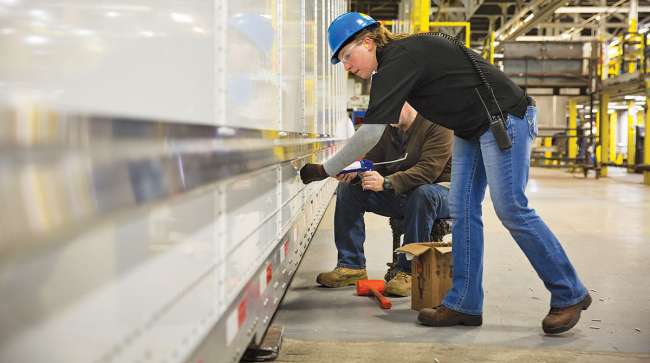Senior Reporter
July Trailer Orders Blow Past 2021’s Low; 2023 Orders Awaken

[Stay on top of transportation news: Get TTNews in your inbox.]
U.S. trailer orders in July roared ahead compared with a year earlier but slumped compared with earlier months this year, ACT Research reported, citing trailer makers’ final data. At the same time, indications are rising that 2023 orders are beginning to find slots.
Net orders were 16,997 compared with the low of 8,128 a year earlier when the supply chain was at its most disrupted, as one trailer maker executive described it then. July’s order volume also was the second lowest this year.
FTR pegged preliminary orders at 17,000.

Giesen
August U.S. trailer orders may jump as some leading trailer makers report they have opened or are about to open 2023 order boards.
Stoughton Trailers started putting orders for Q1 in its order board in August to give supply chain visibility, Vice President of Sales David Giesen said. “I suspect you will see a large number for August.”
Great Dane intends to open up its order boards over the next two weeks for early 2023 builds, Chris Hammond, executive vice president of sales, said Aug. 18.
Utility Trailer recently started quoting deals for 2023 production, said Craig Bennett, senior vice president of sales. “Costing is mixed with some ups and some downs now,” he said. “Supplier capacity is still restraining our ability to produce more trailers, and there are still allocations and limitations from several of our suppliers.”
Supplier capacity is still restraining our ability to produce more trailers.
Craig Bennett, senior vice president of sales for Utility Trailer
Hyundai Translead as of Aug. 18 had not opened its 2023 order board.
“We will be doing so as the supply chain continues to commit,” Chief Sales Officer Sean Kenney said.
But how much unmet demand remains, and how to tell now with no strong flow of trailer orders to symbolize it?

Hammond
“It’s really existing customers that indicate demand is staying high,” Hammond said. “We know there will be some fallout of some fleets that are very heavy in spot rate trucking, though. So I’d say the demand is elevated but a little less than the prior fall.”
Stoughton’s Giesen offered several measuring sticks. There are new customer requests, he said, and waiting, existing customers to whom Stoughton is not giving all they would like.
“There’s re-entry to buying for some that took time off,” he said. “Cancellations are very low. In short, we have a lot more demand than we have capacity going forward.”
Bennett sees demand partly stemming from trailer makers not satisfying the demand this year, so some is spilling over into 2023.

Kenney
At Hyundai Translead, customer feedback on demand remains positive even in light of the current challenges, Kenney said.
So what do manufacturers tell those seeking a trailer right now?
“Unfortunately, that shelf is empty,” Giesen noted.
Hyundai points them to its dealer network.
Hammond said some stock units may be available somewhere, depending on the type of trailer.
“Otherwise, customers are ordering understanding the reality of backlogs in our industry,” he said.

Siamak Azmoudeh of SkyBitz discusses the rise of the smart trailer and why the industry standard is shifting toward more sensors, more data and more business intelligence. He joins host Seth Clevenger to explain the evolution of trailer telematics. Tune in above or by going to RoadSigns.ttnews.com.
Hammond added virtually all trailers that Great Dane builds in next year will be smart trailers.
Great Dane defined a smart trailer as a regular trailer with advanced digital capabilities — refrigerated, dry or flatbed — that has been equipped with integrated IoT technology that provides details into the health and status of the trailer and its cargo.
Bennett said smart trailers are evolving but coming. And new HFC-free foam requirements are a primary focus.
Kenney said many customers continue to evaluate the technological advantages “as they work through the integration and use of the data toward a better-understood return.”
Giesen said a few customers have started to look at additional telematics and explore their options.
Want more news? Listen to today's daily briefing above or go here for more info
Recent survey data from the Technology & Maintenance Council of American Trucking Associations indicates carriers hold a high expectation of receiving tangible improvement from smart products in numerous areas of operational efficiency, TMC Executive Director Robert Braswell noted in a recent article. However, their views on the life cycle and maintenance of smart products or the proper integration of smart data with the carrier TMS is more reserved. Some of the biggest disappointments identified with smart technology include equipment failures, battery life and issues with replacement parts.
For trailer makers, supply chain conditions, rising material costs and labor availability continue to remain inhibiting factors that are making it difficult for manufacturers to increase build rates, according to Charles Roth, commercial vehicle analyst for FTR.
With July’s volume, orders total 275,000 units over the past 12 months, according to FTR.
“With supply and demand out of sync, and expected to remain there for the near to medium term,” ACT Vice President Eric Crawford said in a release, “there is little incentive for a fleet to leave the order board when they already have a committed production slot. While build slot and pricing might not be as firm as fleets would prefer, it’s better than being on the outside looking in.”





